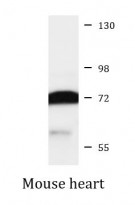ARG40606
anti-CPEB3 antibody
anti-CPEB3 antibody for ICC/IF,IHC-Formalin-fixed paraffin-embedded sections,Western blot and Human,Mouse,Rat
Overview
| Product Description | Rabbit Polyclonal antibody recognizes CPEB3 |
|---|---|
| Tested Reactivity | Hu, Ms, Rat |
| Tested Application | ICC/IF, IHC-P, WB |
| Host | Rabbit |
| Clonality | Polyclonal |
| Isotype | IgG |
| Target Name | CPEB3 |
| Antigen Species | Human |
| Immunogen | Recombinant fusion protein corresponding to aa. 150-400 of Human CPEB3 (NP_055727.3). |
| Conjugation | Un-conjugated |
| Alternate Names | CPE-binding protein 3; CPE-BP3; Cytoplasmic polyadenylation element-binding protein 3; hCPEB-3 |
Application Instructions
| Application Suggestion |
|
||||||||
|---|---|---|---|---|---|---|---|---|---|
| Application Note | * The dilutions indicate recommended starting dilutions and the optimal dilutions or concentrations should be determined by the scientist. | ||||||||
| Positive Control | Mouse heart | ||||||||
| Observed Size | 72 kDa |
Properties
| Form | Liquid |
|---|---|
| Purification | Affinity purified. |
| Buffer | PBS (pH 7.3), 0.02% Sodium azide and 50% Glycerol. |
| Preservative | 0.02% Sodium azide |
| Stabilizer | 50% Glycerol |
| Storage Instruction | For continuous use, store undiluted antibody at 2-8°C for up to a week. For long-term storage, aliquot and store at -20°C. Storage in frost free freezers is not recommended. Avoid repeated freeze/thaw cycles. Suggest spin the vial prior to opening. The antibody solution should be gently mixed before use. |
| Note | For laboratory research only, not for drug, diagnostic or other use. |
Bioinformation
| Database Links |
Swiss-port # Q7TN99 Mouse Cytoplasmic polyadenylation element-binding protein 3 Swiss-port # Q8NE35 Human Cytoplasmic polyadenylation element-binding protein 3 |
|---|---|
| Gene Symbol | CPEB3 |
| Gene Full Name | cytoplasmic polyadenylation element binding protein 3 |
| Function | Sequence-specific RNA-binding protein which acts as a translational repressor in the basal unstimulated state but, following neuronal stimulation, acts as a translational activator (By similarity). In contrast to CPEB1, does not bind to the cytoplasmic polyadenylation element (CPE), a uridine-rich sequence element within the mRNA 3'-UTR, but binds to a U-rich loop within a stem-loop structure (By similarity). Required for the consolidation and maintenance of hippocampal-based long term memory (By similarity). In the basal state, binds to the mRNA 3'-UTR of the glutamate receptors GRIA2/GLUR2 mRNA and negatively regulates their translation (By similarity). Also represses the translation of DLG4, GRIN1, GRIN2A and GRIN2B (By similarity). When activated, acts as a translational activator of GRIA1 and GRIA2 (By similarity). In the basal state, suppresses SUMO2 translation but activates it following neuronal stimulation (By similarity). Binds to the 3'-UTR of TRPV1 mRNA and represses TRPV1 translation which is required to maintain normal thermoception (By similarity). Binds actin mRNA, leading to actin translational repression in the basal state and to translational activation following neuronal stimulation (By similarity). Negatively regulates target mRNA levels by binding to TOB1 which recruits CNOT7/CAF1 to a ternary complex and this leads to target mRNA deadenylation and decay (PubMed:21336257). In addition to its role in translation, binds to and inhibits the transcriptional activation activity of STAT5B without affecting its dimerization or DNA-binding activity. This, in turn, represses transcription of the STAT5B target gene EGFR which has been shown to play a role in enhancing learning and memory performance (PubMed:20639532). In contrast to CPEB1, CPEB2 and CPEB4, not required for cell cycle progression (PubMed:26398195). [UniProt] |
| Cellular Localization | Cytoplasm. Nucleus. Cell junction, synapse. Cell projection, dendrite. Cell junction, synapse, postsynaptic cell membrane, postsynaptic density. Note=Predominantly cytoplasmic in unstimulated neurons but translocates to the nucleus following neuronal stimulation (PubMed:20639532, PubMed:22730302). Nuclear import is mediated by importin IPO5 (By similarity). [UniProt] |
| Calculated MW | 76 kDa |
| PTM | Activated by NEURL1-mediated monoubiquitination, resulting in the growth of new dendritic spines and increased levels of GRIA1 and GRIA2. NEURL1-mediated monoubiquitination facilitates synaptic plasticity and hippocampal-dependent memory storage. Under basal unstimulated conditions when CPEB3 is mainly unaggregated, sumoylated and acts as a translational repressor. Following neuronal stimulation, becomes desumoylated and aggregated which is required for the translation of mRNA targets and for dendritic filopodia formation. Following neuronal stimulation, cleaved by CAPN2 which abolishes its translational repressor activity, leading to translation of CPEB3 target mRNAs. Phosphorylation is enhanced by neuronal stimulation. [UniProt] |
Images (1) Click the Picture to Zoom In






